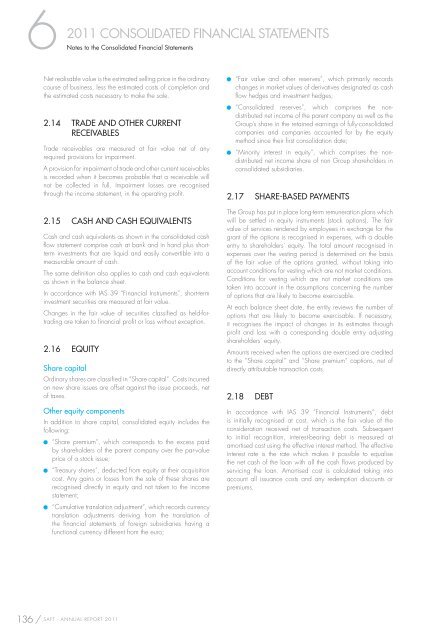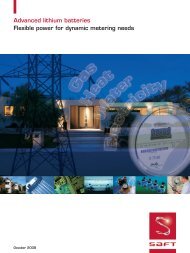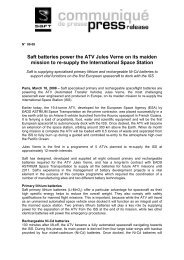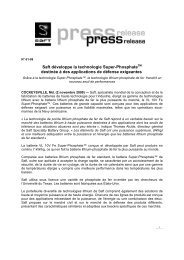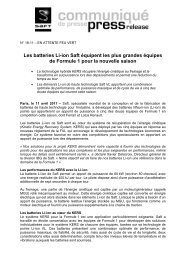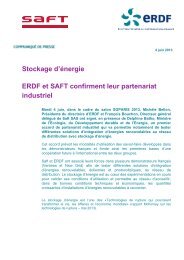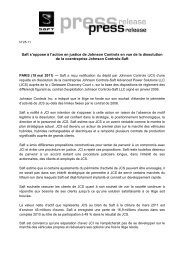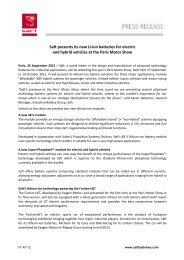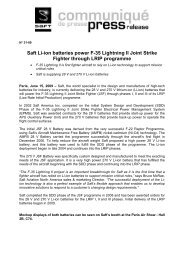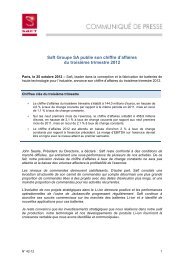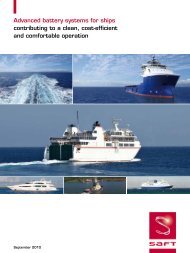ANNUAL REPORT 2011 REGISTRATION DOCUMENT - Saft
ANNUAL REPORT 2011 REGISTRATION DOCUMENT - Saft
ANNUAL REPORT 2011 REGISTRATION DOCUMENT - Saft
You also want an ePaper? Increase the reach of your titles
YUMPU automatically turns print PDFs into web optimized ePapers that Google loves.
6 Notes<br />
<strong>2011</strong> CONSOLIDATED FINANCIAL STATEMENTS<br />
to the Consolidated Financial Statements<br />
Net realisable value is the estimated selling price in the ordinary<br />
course of business, less the estimated costs of completion and<br />
the estimated costs necessary to make the sale.<br />
2.14 TRADE AND OTHER CURRENT<br />
RECEIVABLES<br />
Trade receivables are measured at fair value net of any<br />
required provisions for impairment.<br />
A provision for impairment of trade and other current receivables<br />
is recorded when it becomes probable that a receivable will<br />
not be collected in full. Impairment losses are recognised<br />
through the income statement, in the operating profi t.<br />
2.15 CASH AND CASH EQUIVALENTS<br />
Cash and cash equivalents as shown in the consolidated cash<br />
fl ow statement comprise cash at bank and in hand plus shortterm<br />
investments that are liquid and easily convertible into a<br />
measurable amount of cash.<br />
The same defi nition also applies to cash and cash equivalents<br />
as shown in the balance sheet.<br />
In accordance with IAS 39 “Financial Instruments”, short-term<br />
investment securities are measured at fair value.<br />
Changes in the fair value of securities classifi ed as held-fortrading<br />
are taken to fi nancial profi t or loss without exception.<br />
2.16 EQUITY<br />
Share capital<br />
Ordinary shares are classifi ed in “Share capital”. Costs incurred<br />
on new share issues are offset against the issue proceeds, net<br />
of taxes.<br />
Other equity components<br />
In addition to share capital, consolidated equity includes the<br />
following:<br />
� “Share premium”, which corresponds to the excess paid<br />
by shareholders of the parent company over the par-value<br />
price of a stock issue;<br />
� “Treasury shares”, deducted from equity at their acquisition<br />
cost. Any gains or losses from the sale of these shares are<br />
recognised directly in equity and not taken to the income<br />
statement;<br />
� “Cumulative translation adjustment”, which records currency<br />
translation adjustments deriving from the translation of<br />
the fi nancial statements of foreign subsidiaries having a<br />
functional currency different from the euro;<br />
136 / SAFT - <strong>ANNUAL</strong> <strong>REPORT</strong> <strong>2011</strong><br />
� “Fair value and other reserves”, which primarily records<br />
changes in market values of derivatives designated as cash<br />
fl ow hedges and investment hedges;<br />
� “Consolidated reserves”, which comprises the nondistributed<br />
net income of the parent company as well as the<br />
Group’s share in the retained earnings of fully-consolidated<br />
companies and companies accounted for by the equity<br />
method since their fi rst consolidation date;<br />
� “Minority interest in equity”, which comprises the nondistributed<br />
net income share of non Group shareholders in<br />
consolidated subsidiaries.<br />
2.17 SHARE-BASED PAYMENTS<br />
The Group has put in place long-term remuneration plans which<br />
will be settled in equity instruments (stock options). The fair<br />
value of services rendered by employees in exchange for the<br />
grant of the options is recognised in expenses, with a double<br />
entry to shareholders’ equity. The total amount recognised in<br />
expenses over the vesting period is determined on the basis<br />
of the fair value of the options granted, without taking into<br />
account conditions for vesting which are not market conditions.<br />
Conditions for vesting which are not market conditions are<br />
taken into account in the assumptions concerning the number<br />
of options that are likely to become exercisable.<br />
At each balance sheet date, the entity reviews the number of<br />
options that are likely to become exercisable. If necessary,<br />
it recognises the impact of changes in its estimates through<br />
profi t and loss with a corresponding double entry adjusting<br />
shareholders’ equity.<br />
Amounts received when the options are exercised are credited<br />
to the “Share capital” and “Share premium” captions, net of<br />
directly attributable transaction costs.<br />
2.18 DEBT<br />
In accordance with IAS 39 “Financial Instruments”, debt<br />
is initially recognised at cost, which is the fair value of the<br />
consideration received net of transaction costs. Subsequent<br />
to initial recognition, interest-bearing debt is measured at<br />
amortised cost using the effective interest method. The effective<br />
interest rate is the rate which makes it possible to equalise<br />
the net cash of the loan with all the cash fl ows produced by<br />
servicing the loan. Amortised cost is calculated taking into<br />
account all issuance costs and any redemption discounts or<br />
premiums.


